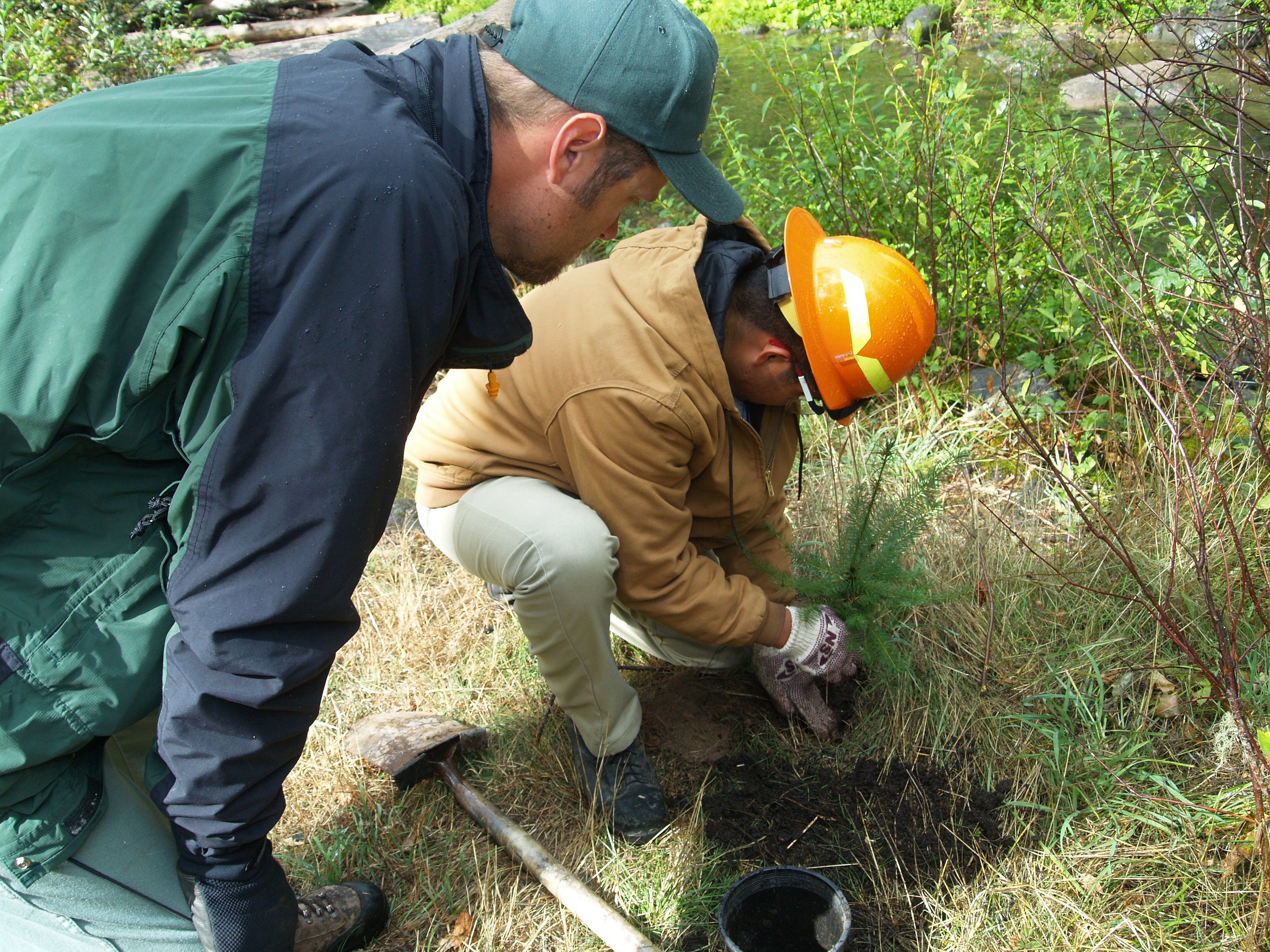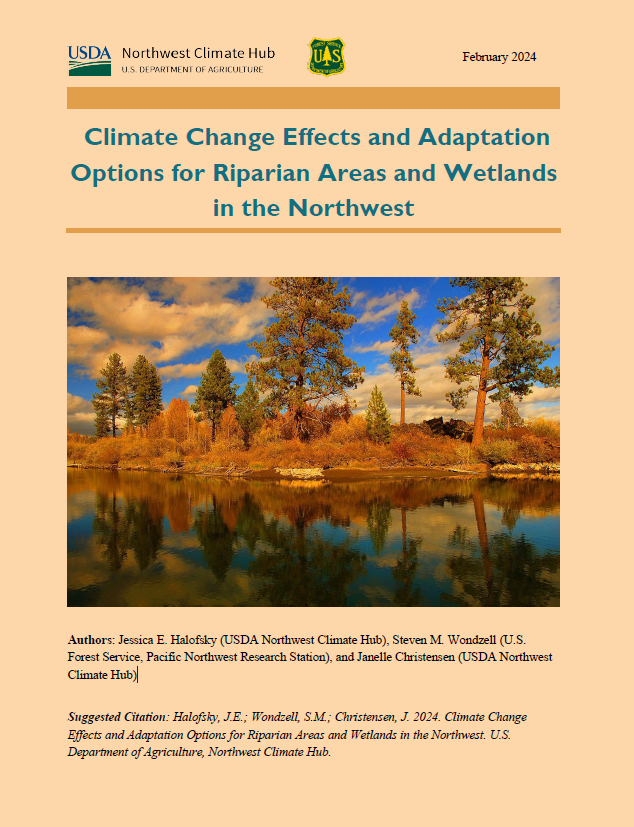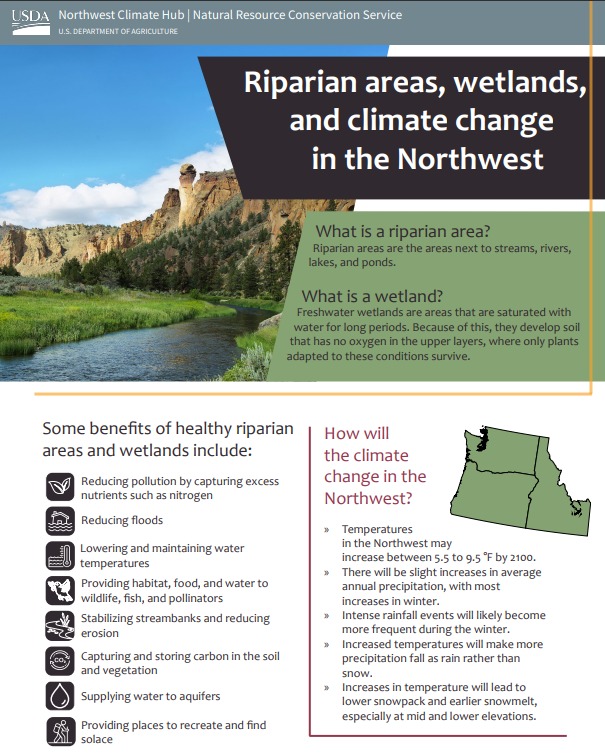Riparian areas are the areas next to streams, rivers, lakes, and ponds. Freshwater wetlands are areas that are saturated with water for long periods. Because of this, they develop soil that has little to no oxygen in the upper layers, where only plants adapted to these conditions survive.
Benefits of healthy riparian areas and wetlands include:
- Reducing pollution by capturing excess nutrients such as nitrogen
- Reducing floods
- Lowering and maintaining water temperatures
- Providing habitat, food, and water to wildlife, fish, and pollinators
- Stabilizing streambanks and reducing erosion
- Capturing and storing carbon in the soil and vegetation
- Supplying water to aquifers
- Providing places to recreate and find solace

Climate change, riparian areas, and wetlands
In the Northwest, climate change may cause temperature increases between 5.5 to 9.5 °F by 2100. Warmer temperatures will cause more precipitation to fall as rain rather than snow, which will decrease snowpack and result in earlier snowmelt, especially at mid and lower elevations. In addition, most climate projections show slight increases in average annual precipitation, with most increases in winter. Although the amount of precipitation will not increase much, precipitation patterns may change. Most climate projections show intense rainfall events becoming more frequent during the winter, which can result in flooding.
How will climate change affect riparian areas and wetlands?

Riparian areas and wetlands across the Northwest will be affected by different factors. The diversity of these places means climate change will affect each one differently. One major factor to consider is the hydrology of the stream and floodplain. Hydrologic processes between different streams and wetlands can be significant. Factors like precipitation, soil, and aquifer storage determine how and where water flows. Each of these could experience impacts from climate change.
How these areas respond to climate change also depends on historical land use. Riparian plants could be more vulnerable to climate change if stream flows (e.g., dams) were altered. For example, some historical actions incised stream channels. This can disconnect a stream from the floodplain and decrease summertime water availability. As a result, riparian plants may dry out in the summer.
Climate change may make it harder for riparian plants to get the water they need. As plants experience water stress, riparian and wetland vegetation may change. But riparian plants may not respond the same to climate change in each place. How they respond will depend on how much water is available. If stream flows shift to earlier in the spring, plants may experience more water stress. A longer summer draw-down period (when streams remove water from the aquifer) could also increase plant water stress. Also, many wetland plants are very sensitive to changes in water table elevation. In wetlands where water tables decline, wetland species will be affected. Last, higher temperatures and increased drought may decrease soil water available to plants. These places may no longer support the same plant life if these changes occur. As a result, species composition may shift.
What can I do to reduce the negative effects of climate change on riparian areas and wetlands?

- Avoid removing trees and shrubs, and plant trees in riparian areas. This will increase shade over streams, minimizing stream temperature increases. This, in turn, will help aquatic plants and animals that are sensitive to temperature changes
- In fire-prone ecosystems, reduce fuels in nearby upland vegetation. In places such as dry forests east of the Cascade Mountains, this will be crucial. This can help by reducing the risk of high-severity fire in riparian areas and wetlands. Along small streams in dry forests, consider fuel treatments in riparian areas.
- Restore streams. Stream restoration will improve stream channel stability and complexity, which will slow water movement and increase water storage. Restored streams increase resilience to both low and high flows as well as improve aquatic habitat.
- Reduce flooding intensity. This can be done by:
- Reconnecting stream channels to floodplains.
- Maintaining native plant species in riparian areas and wetlands.
- Reduce existing, non-climatic stressors in riparian areas and wetlands. This is likely to help them better withstand the effects of climate change. For example, managing livestock and recreation use will reduce stress on riparian areas and wetlands.
-
Riparian Areas, Wetlands, and Climate Change Technical Guide

-
Riparian Areas, Wetlands, and Climate Change Factsheet




